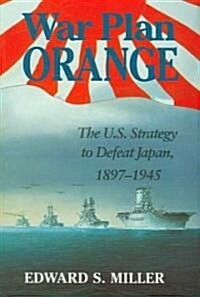
단행본
War Plan Orange: the U.S. strategy to defeat Japan, 1897-1945
- 개인저자
- Edward S. Miller
- 발행사항
- Annapolis, Md. : Naval Institute Press, 1991
- 형태사항
- xxi, 509, [16] p. of plates : ill., maps ; 24 cm
- ISBN
- 9781591145004
- 청구기호
- 397.10942 M647w
- 서지주기
- Includes bibliographical references (p. [455]-475) and index
소장정보
| 위치 | 등록번호 | 청구기호 / 출력 | 상태 | 반납예정일 |
|---|---|---|---|---|
이용 가능 (1) | ||||
| 1자료실 | 00013046 | 대출가능 | - | |
이용 가능 (1)
- 등록번호
- 00013046
- 상태/반납예정일
- 대출가능
- -
- 위치/청구기호(출력)
- 1자료실
책 소개
Based on twenty years of research in formerly secret archives, this book reveals for the first time the full significance of War Plan Orange - the U.S. Navy's strategy to defeat Japan, formulated over the forty years prior to World War II. It recounts the struggles between ""thrusting"" and ""cautionary"" schools of strategy, the roles of outspoken leaders such as Dewey, Mahan, King, and MacArthur, and the adaptation of aviation and other technologies to the plan. The book shows that the strategy of Plan Orange was the basis of pre-war U.S. naval development in training, ship and aircraft design, and amphibious and tactical thought.<br><br><em>War Plan Orange</em> is the recipient of numerous book awards, including the prestigious Theodore and Franklin Roosevelt Naval History Prize.
Based on twenty years of research in formerly secret archives, this book reveals for the first time the full significance of War Plan Orange - the US Navy's strategy to defeat Japan, formulated over the forty years prior to World War II. It recounts the struggles between “thrusting” and “cautionary” schools of strategy, the roles of outspoken leaders such as Dewey, Mahan, King, and MacArthur, and the adaptation of aviation and other technologies to the plan.
Based on twenty years of research in formerly secret archives, this book reveals for the first time the full significance of War Plan Orange - the US Navy's strategy to defeat Japan, formulated over the forty years prior to World War II. It recounts the struggles between “thrusting” and “cautionary” schools of strategy, the roles of outspoken leaders such as Dewey, Mahan, King, and MacArthur, and the adaptation of aviation and other technologies to the plan.

